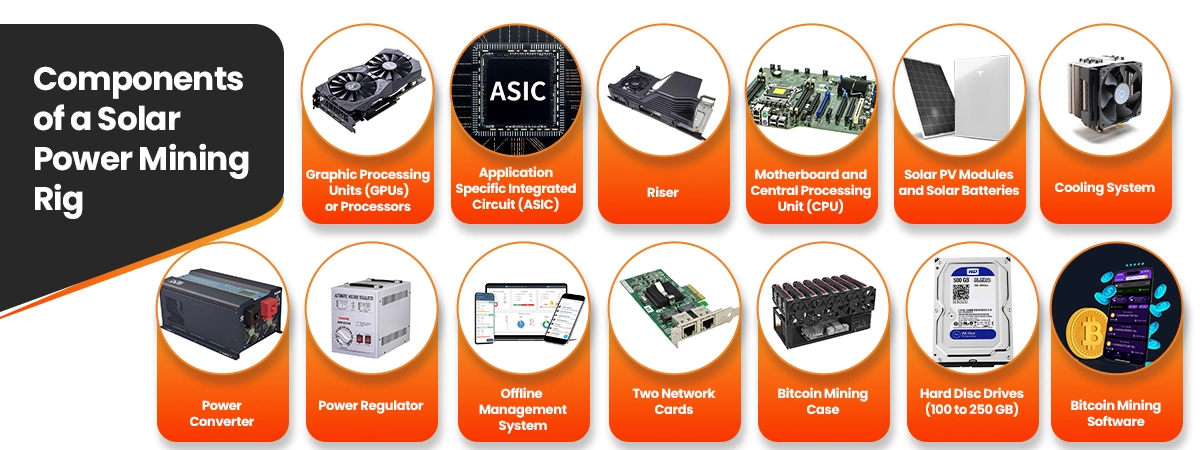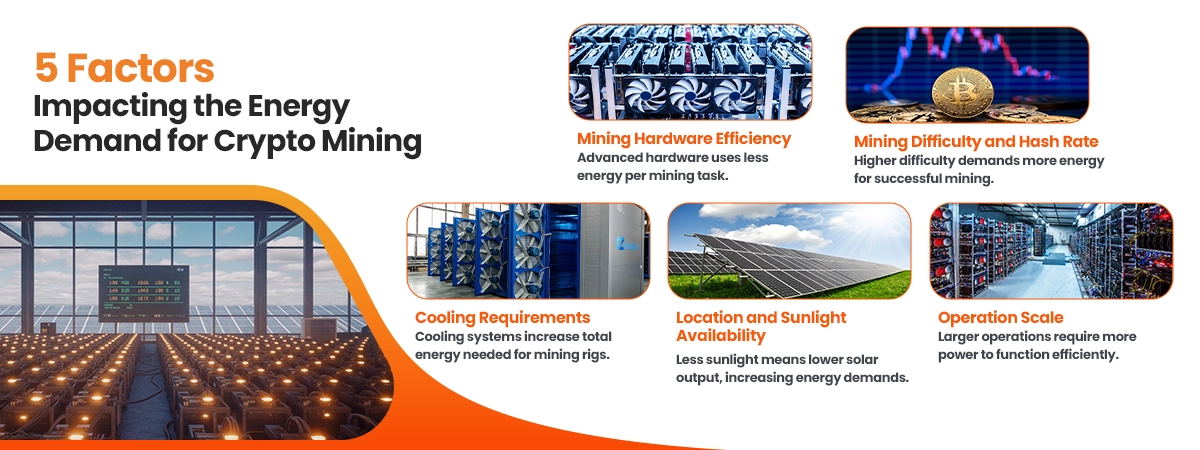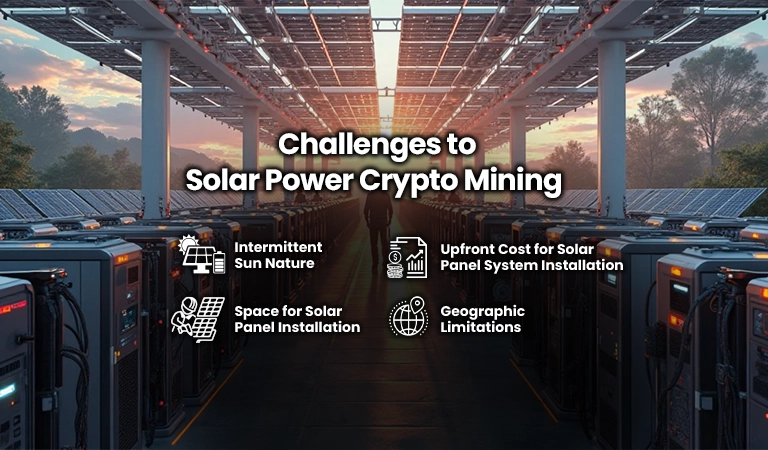- Updated On: July 02, 2025
Solar Power Crypto Mining:
Making Digital Currency Renewable
Technology is evolving and it is now transforming the way we power our digital world. Solar-powered crypto mining is one of the new innovations becoming popular as the need for cryptocurrency rises in tandem with the demand for power efficient and eco-friendly means of mining it. The traditional mining rig depends on fossil fuel-based electricity, which is costly and harmful to the environment. But solar energy is now stepping up as the game-changer. Using sunlight to power mining rigs, people are lowering energy expenses. It’s a smart, cutting-edge solution that integrates two of the cutting-edge industries: clean energy and blockchain technology.

Whether you’re a beginner miner or simply looking to upgrade your setup, in this article, we will explore how solar energy can play its role in crypto mining and the benefits of solar powered mining. Also, we will have a look at the current challenges.
How many solar panels do you need for crypto mining?
Using solar power for cryptocurrency mining is possible. Nearly 6000 watts of solar panels are required to power a cryptocurrency mining rig during the day and recharge the battery at night if several GPUs are being used for mining. Additionally, the amount of energy required for the mining device determines the number of solar panels needed. The number of solar panels you require depends on a number of factors, including:
- The type of solar panels
- The space you have for panels
- Location
- The area on the roof
Solar panels are placed where the sun shines the brightest. An estimated 6 to 12 square meters are required for a solar panel in cloud cover. The GPUs must be powered by an effective solar battery system to store energy at night.
What is the composition of the solar power crypto mining rig?
Solar power mining rig is the setup through which the block addition into the blockchains takes place. This setup includes:

How much solar power is required to mine bitcoin?
To keep solar-powered bitcoin mining running, good solar-capacity planning is required. The amount of solar energy needed for bitcoin mining depends on a few factors such as: the operation, the effectiveness of the hardware, and the amount of sunlight in the area. However, estimates range from 500 watts to 1.5 kilowatts for a single bitcoin mining device. Assuming an average utilization of one kilowatt per rig, approximately ten solar panels, each with an average capacity of 300 watts, would be needed to generate enough electricity for one rig. A modest mining company with ten rigs would require 100 solar panels roughly, or 30 kilowatts, to cover its power needs.
The power consumption of a mining rig is typically measured in watts (W) or kilowatts (kWh). It can range from a few hundred watts to several kilowatts or even megawatts for large-scale mining operations. The power consumption of a mining rig can vary depending on various factors, which include the mining algorithm used and the level of utilization. Some algorithms, such as Ethereum’s Ethash, are less power-intensive than others. High utilization can cause the hardware to consume more power than it would under normal conditions.
What factors impact the energy demand for solar power crypto mining?
GPUs of Solar mining crypto rigs are linked to their energy use. A typical solar mining rig system requires between 400 and 500 watts of electricity on a daily basis, and its power efficiency depends on factors, including the GPUs used and the sunlight available. If additional GPUs are added to the mining machine, this might rise to 900–1500 watts.

Furthermore, the amount of sunlight also impacts the energy requirement of solar power crypto mining. The sunnier the region, the greater the energy production, and the fewer number of solar panels required. A typical sunny day in the United States will yield about 5500 watts of electricity, which means 229 watts of electricity per day. So, in order to run a single rig, you will require three square meters of solar panels and six square meters for multiple rigs.
In the United States, on a typical day, the sun is out for roughly 11 hours, leaving 13 hours of the day without any light. So, we need an alternative storage device, like solar batteries, to run a mining rig on solar power. In order to charge these batteries, you have to double the number of solar panels. So, instead of three to six square meters, you need six to twelve square meters to sustain the power requirement of a solar power crypto mining rig.
What are the benefits of solar power mining rigs?
Solar-powered crypto mining equipment has many benefits. These include scalability, energy independence, and cost savings. In recent years, using renewable energy to power businesses, including bitcoin mining, has become popular. Solar power is a promising, sustainable option for mining rigs because:

1. Cost-Effective:
Solar power crypto mining is a one-time investment. Solar panels can last about 25 to 30 years. With fossil fuel-powered electrical energy, you have to deal with monthly electric bills. But once you go solar, you will be free from this monthly hassle. Plus, if your solar PV modules produce excess electricity, you can supply it to the power grid in exchange for solar credits. Therefore, solar power crypto mining is very cost-effective when it comes to price.
2. No Power Outages:
When using power from the grid, you have to deal with problems like inconsistent electrical power transmission and blackouts. This can eventually cause hindrances in the process of blockchain mining. When it comes to crypto mining, a constant and regular supply of electricity is vital. Therefore, solar with battery systems can provide a consistent source of electricity, which is also a renewable source .
3. Faster Payback Period:
With solar power crypto mining, you will be able to get the return on your investment much faster. Through crypto mining, you will be able to earn in terms of bitcoin alongside not having to pay electric bills every single month. This will eventually shorten your payback period much shorter. This eventually will make solar power crypto mining a much better investment in the long run.
4. Self-Reliant:
Solar systems give you total control over your electrical power production. It provides you with freedom and self-reliance over how much electricity you will produce and how much you will spend, without imposing any limits. Solar power is also quite economical, despite the hefty initial solar investment. With solar panels, you can harness solar energy according to your needs and stop worrying about onerous electric bills.
5. Scalability:
Another benefit of solar power mining rigs is their scalability. Solar power systems can be easily expanded or reduced in size depending on the needs of the miner. This can help miners who want to expand or who are in remote areas that need a custom power solution.
What are the challenges to solar power crypto mining?
Even though the popularity of solar power crypto mining is on the rise, it has both pros and cons that miners must consider before going solar:

1. Intermittent Sun Nature:
One of the main challenges of solar power crypto mining is the intermittency of solar energy. Solar panels can only generate electricity when the sun is shining, high, and bright. This means that mining operations may need to be shut down during periods of low sunlight, like on cloudy days and in winter. Otherwise, an alternative source of energy needs to be used to supplement the power needs of crypto mining. This is why a 50 Ah voltage battery is installed alongside the solar panels, which can further hike up the initial installation cost of solar panels.
2. The Upfront Cost for Solar Panel System Installation:
Solar energy will cost less overtime. But the initial investment can be high. This can be an issue for small-scale miners or those with limited resources.
3. Space for Solar Panel Installation:
Mining crypto is a process that demands large amounts of energy, resulting in the need for more solar panels. More solar panels mean more space requirement for their installation. Therefore, limiting the scope of solar crypto mining.
4. Geographic Limitations:
The effectiveness of solar PV modules can vary depending on geographic location. In areas with less sunlight or a higher frequency of cloudy days, solar power may not be as effective for powering crypto mining rigs. In some areas, there may be restrictions on the size or capacity of the solar panel system. This will eventually limit the amount of energy generated through solar arrays. In some locations, miners face the problem of obtaining the necessary approvals or permits to set up solar PV modules.
Which are the best states to mine solar-powered cryptocurrency?
Currently, the USA is leading the way in solar power crypto mining with its advance solar technology. The following are the states where electricity production with solar is the greatest:

In short, solar powered crypto mining has many benefits. It includes lower electricity costs and a smaller carbon footprint. But it also has its own set of drawbacks, such the erratic nature of solar power and the initial installation costs.
Cryptocurrency miners use smart mining algorithms, energy storage, and efficient gear to optimize their work. By utilizing the power of the sun, they can help create a more sustainable future. The world’s search for new technologies and energy sources will likely change the way of crypto mining.
Related Articles:
The smart grid is a modern development of a traditional electrical grid. This new system uses digital technologies to connect the power utilities and the consumers.
Microgrids are revolutionizing the current energy system because they provide an efficient, safe, reliable, and sustainable energy supply.
Solar panel technology is entering a new era, driven by innovative breakthroughs transforming the energy landscape.



